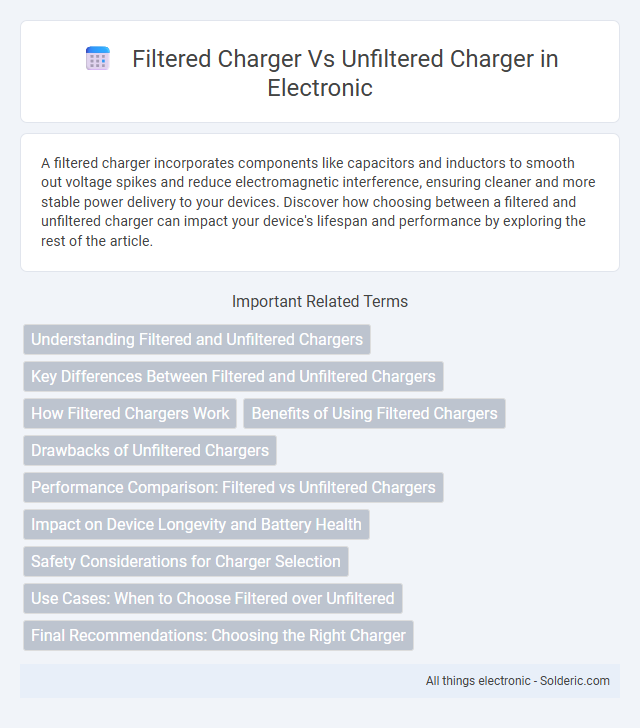A filtered charger incorporates components like capacitors and inductors to smooth out voltage spikes and reduce electromagnetic interference, ensuring cleaner and more stable power delivery to your devices. Discover how choosing between a filtered and unfiltered charger can impact your device's lifespan and performance by exploring the rest of the article.
Comparison Table
| Feature | Filtered Charger | Unfiltered Charger |
|---|---|---|
| Power Quality | Provides stable and clean power with noise filtering | Delivers raw power with potential electrical noise |
| Device Protection | Reduces risk of damage from voltage spikes and interference | Offers minimal protection against voltage fluctuations |
| Charging Efficiency | Consistent charging rate with reduced energy loss | Variable charging efficiency, may cause heating |
| Cost | Higher upfront cost due to filtering components | Lower cost, simpler design |
| Usage Scenario | Ideal for sensitive devices and long-term durability | Suitable for basic or short-term charging needs |
Understanding Filtered and Unfiltered Chargers
Filtered chargers use electronic components to smooth out voltage fluctuations, providing a more stable and consistent power supply to your devices. Unfiltered chargers lack these components, which can result in more electrical noise and potential interference, affecting the performance and longevity of sensitive electronics. Choosing a filtered charger ensures better protection and efficiency, especially for high-precision or sensitive equipment.
Key Differences Between Filtered and Unfiltered Chargers
Filtered chargers incorporate electronic components that reduce electrical noise and voltage spikes, ensuring a stable and clean power output. Unfiltered chargers lack these components, which can lead to power fluctuations potentially harming sensitive devices or reducing charging efficiency. Understanding these differences helps you choose the right charger to protect your electronics and maintain optimal performance.
How Filtered Chargers Work
Filtered chargers use electronic components such as inductors, capacitors, and filters to smooth out voltage fluctuations and reduce electrical noise during the charging process. These chargers provide a stable and clean power output, protecting your device's battery from potential damage caused by voltage spikes or electromagnetic interference. By maintaining a consistent current, filtered chargers enhance charging efficiency and prolong battery lifespan compared to unfiltered chargers.
Benefits of Using Filtered Chargers
Filtered chargers reduce electrical noise and voltage fluctuations, providing a more stable power supply to devices and enhancing their longevity. The built-in noise suppression components in filtered chargers minimize electromagnetic interference, improving device performance and reducing potential damage. Using filtered chargers also helps protect sensitive electronics from power surges and spikes, ensuring safer and more reliable operation.
Drawbacks of Unfiltered Chargers
Unfiltered chargers often produce electrical noise and voltage spikes that can damage sensitive electronic components and reduce battery lifespan. They lack the necessary circuitry to stabilize output, causing inconsistent power delivery and increased risk of overheating. This instability can lead to performance issues and potential safety hazards in connected devices.
Performance Comparison: Filtered vs Unfiltered Chargers
Filtered chargers deliver more stable voltage and reduce electrical noise, enhancing device performance and longevity compared to unfiltered chargers. Unfiltered chargers may cause voltage fluctuations and electromagnetic interference, potentially leading to inconsistent charging speeds and reduced efficiency. Choosing a filtered charger ensures your devices receive cleaner power, promoting optimal performance and safer operation.
Impact on Device Longevity and Battery Health
Filtered chargers regulate voltage and current fluctuations, reducing electrical noise and minimizing stress on the device's internal components, which enhances battery health and extends device longevity. Unfiltered chargers may expose devices to inconsistent power delivery, leading to increased heat generation, accelerated battery degradation, and potential damage to sensitive circuits over time. Choosing a filtered charger ensures stable power output, preserving battery capacity and maintaining overall device performance for a longer period.
Safety Considerations for Charger Selection
A filtered charger incorporates noise reduction and voltage regulation features that protect connected devices from electrical surges and electromagnetic interference, enhancing overall safety. Unfiltered chargers lack these protective mechanisms, increasing the risk of damage to sensitive electronics and potential overheating hazards. Selecting a filtered charger ensures compliance with electrical safety standards and reduces the chances of device malfunction or fire incidents.
Use Cases: When to Choose Filtered over Unfiltered
Filtered chargers are ideal for sensitive electronic devices such as medical equipment, high-end audio systems, and precision instruments that require stable voltage and minimal electromagnetic interference to function correctly. Unfiltered chargers suit general-purpose applications like charging smartphones, tablets, and basic consumer electronics where minor voltage fluctuations and noise do not impact performance. Selecting filtered chargers ensures enhanced protection and reliability in environments with unstable power sources or high electromagnetic interference.
Final Recommendations: Choosing the Right Charger
Filtered chargers provide cleaner power output by reducing noise and voltage fluctuations, which helps protect sensitive electronics and improve battery longevity. Unfiltered chargers are typically cheaper but may cause inconsistent charging and potential damage over time due to electrical disturbances. For optimal performance and safety, you should choose a filtered charger that matches your device's specifications and usage patterns.
filtered charger vs unfiltered charger Infographic

 solderic.com
solderic.com